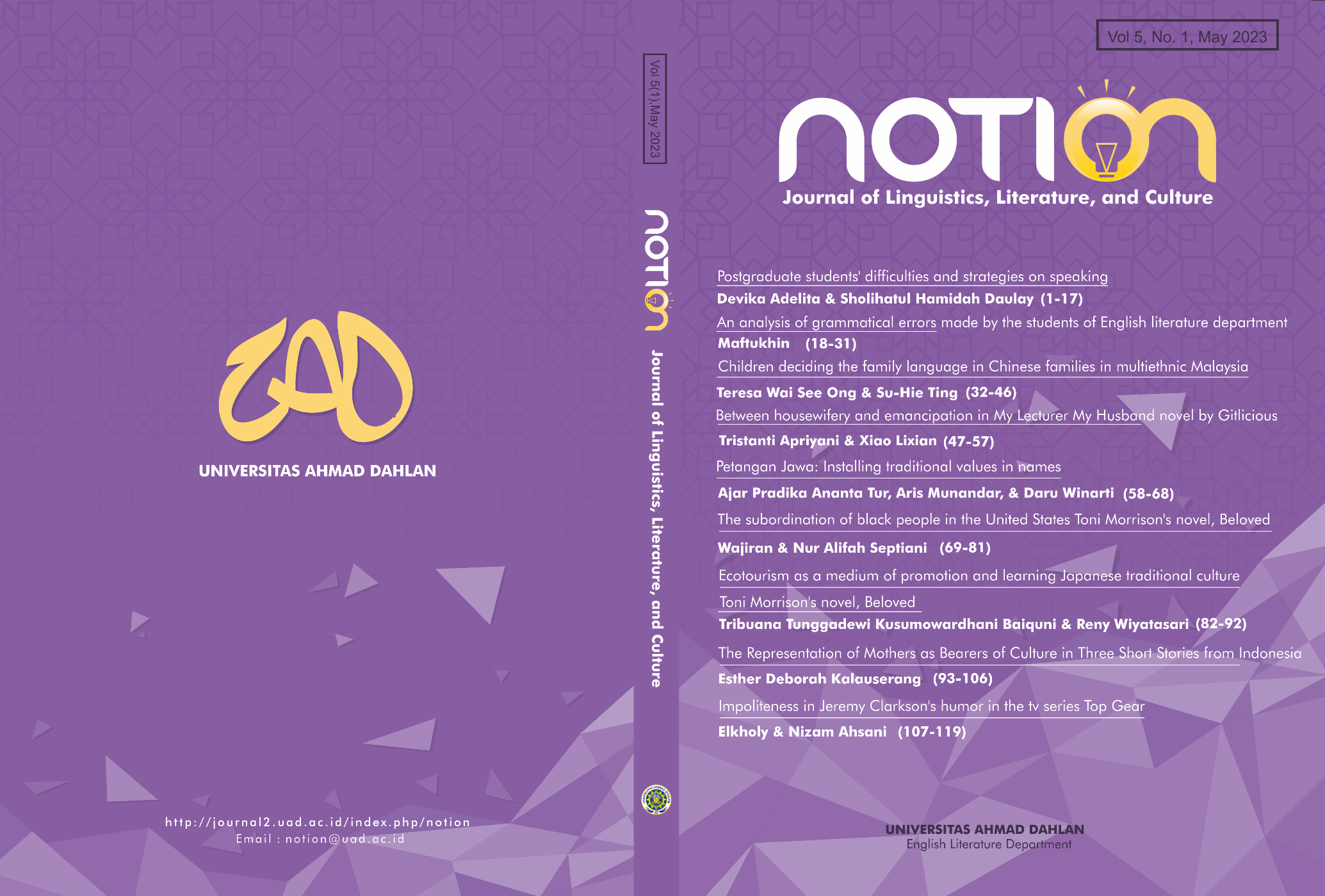The subordination of black people in the United States Toni Morrison’s novel, Beloved
DOI:
https://doi.org/10.12928/notion.v5i1.7064Keywords:
black people, human right, social class, stratification, white supremacyAbstract
This paper is aimed at discussing Morrison’s novel, Beloved dealing with the issues of human discrimination in the United States. Morrison is a writer who voices human values through discussions on issues of discrimination due to ethnicity, race, and skin color, especially that conducted against black people. She was instrumental in fighting for civil and political rights for black people in the United States, especially in Ohio. This study involves the theory of genetic structuralism to understand the concept of white supremacy. This is intended to see the relationship between white supremacy with the issues of social discrimination in the context of black people in the United States depicted in the novel. The issue of race and social class has always stood out in various groups of people. Even though society has progressed the issues of race, religion, and skin color still cause intergroup conflicts due to various interests. As depicted in the novel, black people are generally side-lined and considered only half human. Consequently, black citizens in the United States are associated with slavery or manual labor).
References
Bouacida, S. (2021). Childhood is “not a story to pass on”: Trauma and memory paradox in Toni Morrison’s God Help the Child. Jordan Journal of Modern Languages and Literatures, 13(3), p. 399–410. Retrieved from www.languageinindia.com
Cons of Act (H.R. 7120). (2020). Cons of Act (H.R. 7120): Should congress pass the George Floyd Justice in Policing Act to reform U.S. Policing Practices and Increase Accountability? Congressional Digest, 99(7), p. 19–29. https://www.congress.gov/bill/116th-congress/house-bill/7120
Davis, K. C. (1998). “Postmodern Blackness”: Toni Morrison’s Beloved and the end of history. Twentieth Century Literature, 44(2), p. 242. https://doi.org/10.2307/441873
Doctorow, E. L. (1976). Writers and politicians. The New York Times. Retrieved from https://www.nytimes.com/1976/04/11/archives/writers-and-politicians.html
Fatmasari, Y. (2016). Womb control in Toni Morrison’s Beloved. Jurnal Poetika, 4(1), p. 31–48. https://doi.org/10.22146/poetika.v4i1.13312
Herminingrum, S. (2010). Four criteria for labeling black women and their community as “others” in Toni Morrison’s novels. Jurnal Humaniora, 22(3), 231–240. Retrieved from http://jurnal.ugm.ac.id/index.php/jurnal-humaniora/article/view/998
Hevesi, D. (1988). Toni Morrison’s novel “beloved” wins the pulitzer prize in fiction. New York Times. Retrieved from April 1, 2021. https://www.nytimes.com/1988/04/01/nyregion/toni-morrison-s-novel-beloved-wins-the-pulitzer-prize-in-fiction.html
Ingle, S. (2007). Lies, damned lies and literature: George Orwell and “the truth.” British Journal of Politics and International Relations, 9(4), 730–746. https://doi.org/10.1111/j.1467-856X.2007.00298.x
Krumholz, L. (1992). The ghosts of slavery: Historical recovery in Toni Morrison’s Beloved. African American Review, 26(3), 395. https://doi.org/10.2307/3041912
Melus, S., & Tettenborn, E. (2006). Melancholia as Resistance in Contemporary African American Literature Author ( s ): Éva Tettenborn Published by : Oxford University Press on behalf of Society for the Study of the Multi- Ethnic Literature of the United States ( MELUS ) Stable URL : https: 31(3), 101–121. https://doi.org/10.1093/melus/31.3.101
Morant, B. (1998). Law, literature, and contract: An essay in realism. Michigan Journal of Race and Law, 4(1), p. 1. https://core.ac.uk/download/232704888.pdf
Morrison, T., & Stepto, R. (1977). “Intimate things in place”: A converstation with Toni Morrison. The Massachusetts Review, 18(3), 473–489. https://www.jstor.org/stable/25088764
Nadhifah, N. L. (2012). Beban ganda yang dialami perempuan kulit hitam dalam dua novel Toni Morrison, A Mercy dan Home. Lensa, Vol. 7(1), p. 35–51. https://jurnal.unimus.ac.id/index.php/lensa/article/view/2265
Neilson, D. (2007). Formal and real subordination and re-coupling marxist class theory and labour-process analysis. Capital & Class, Vol. 31(1), p. 89–124. https://journals.sagepub.com/doi/10.1177/030981680709100105
Parker, E. (2001). A new hystery: History and hysteria in Toni Morrison’s “Beloved.” Twentieth Century Literature, 47(1), p. 1–19. https://doi.org/10.1215/0041462X-2001-2006
Rigney, B. H. (1991). The Voices ofToni Morrison (Charlotte Dihoff, ed.). United States: Ohio States University.
Rody, C. (1995). Toni Morrison’s Beloved: History, “rememory,” and a “clamor for a kiss.” American Literary History, 7(1), p. 92–119. https://doi.org/10.1093/alh/7.1.92
Rushdy, A. H. A. (2012). Daughters Signifyin ( g ) history : The Example of Toni Morrison ’ s Beloved Ashraf Rushdy Signifyin ( g ) History : Daughters Beloved of Toni Morrison’s The Example. Daughters, 64(3), p. 567–597. https://www.jstor.org/stable/2927752
Schur, R. L. (2004). Locating “paradise” in the post-civil rights era: Toni Morrison and critical race theory. Contemporary Literature, 45(2), p. 276–299. https://www.jstor.org/stable/3593567
Setyoningsih, D. L. (2014). Death drive : A negative impact of racial abuse in Toni Morrison’s Beloved. https://repository.unej.ac.id/xmlui/bitstream/handle/123456789/68040/Dhini%20Lela%20Setyoningsih.pdf?sequence=1
Suseno, F. M. (2001). Pemikiran Karl Marx: Dari sosialisme utopis ke perselisihan revisionisme. Jakarta: Gramedia.
Swencionis, J. K., Dupree, C. H., & Fiske, S. T. (2017). Warmth-competence tradeoffs in impression management across race and social-class divides. Journal of Social Issues, 73(1), p.175–191. https://doi.org/10.1111/josi.12210
Zamalin, A. (2014). Beloved citizens: Toni Morrison’s “Beloved”, racial inequality, and American public policy. Women’s Studies Quarterly, 42(1), p. 205–211. https://www.jstor.org/stable/24364924
Downloads
Published
Issue
Section
License
Copyright (c) 2023 Wajiran Wajiran, Nur Alifah Septiani

This work is licensed under a Creative Commons Attribution 4.0 International License.
Authors who publish their articles in NOTION: journal of Linguistics, Literature, and Culture agree to the following terms:
- Authors retain the copyright and grant the journal right of first publication with the work simultaneously licensed under a Creative Commons Attribution 4.0 International License that allows others to share the work with an acknowledgement of the work's authorship and initial publication in this journal.
- Authors are able to enter into separate, additional contractual arrangements for the non-exclusive distribution of the journal's published version of the work (e.g., post it to an institutional repository or publish it in a book), with an acknowledgement of its initial publication in this journal.
- Authors are permitted and encouraged to post their work online (e.g., in institutional repositories or on their website) prior to and during the submission process, as it can lead to productive exchanges, as well as earlier and greater citation of published work.





